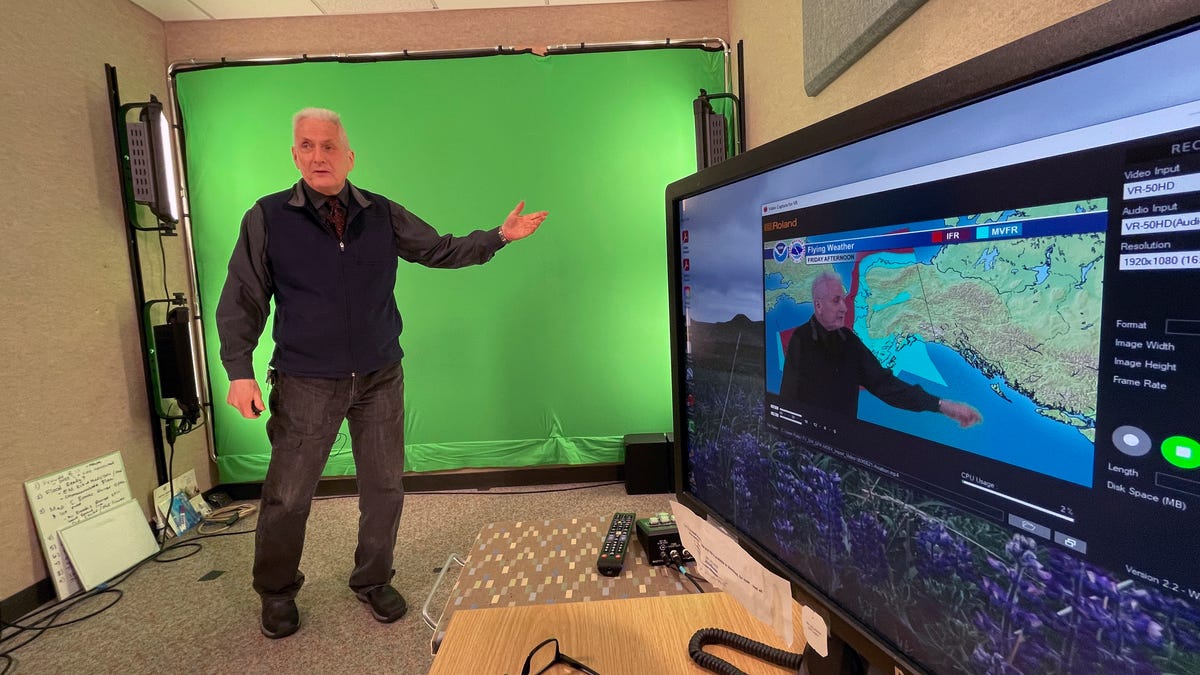
Weather is big news in Alaska. In a place where many people’s lives and livelihoods are directly tied to the environment, knowing what’s in the forecast is often a question of survival. Very soon though, the state’s most reliable source of meteorology media is set to disappear.
“Alaska Weather,” a daily 30-minute TV show that has broadcast across Alaska for the past 47 years, is going off the air due to a lack of funds. In lieu of the news, residents seeking information on their state’s weather will be forced to lean on spotty, sub-par internet. Friday evening will be the final television installment of “Alaska Weather,” as first reported by Alaska Public Media.
Advertisement
The show, which is the only weather program produced directly by the National Weather Service, has filled an information and communications void for decades. Without it, “if you don’t have good internet connectivity, you’re in a world of hurt in western and northern Alaska as far as getting weather information,” said Rick Thoman, a climate specialist at the International Arctic Research Center, to the Associated Press. And many in Alaska don’t have reliable or fast internet access.
More than a third of the state’s rural residents have no wired broadband connection, according to an earlier report from Alaska Public Media. Large swathes of the state are without internet infrastructure. For those who do have internet, it often goes down or fails to operate at a high enough rate to enable video streaming. Earlier this month, an undersea communication cable was severed, triggering an internet outage for Arctic Alaskan communities that could last for weeks. Moreover, paying for internet access can be a big burden for Alaskans, many of whom live below the poverty level.
Advertisement
Advertisement
In much of rural Alaska, there is also no local news offering weather broadcasts. Many households in the vast and remote state only have access to a couple of TV channels, compiled and distributed by Alaska Rural Communications Service—a state-owned, low-power network of transmitters.
On one of those stations, a partnership between Alaska Public Media and NWS ensured that “Alaska Weather” aired each day at 5:30 P.M.—providing viewers with information on emergency alerts, general weather, and aviation and maritime forecasts. Tuning into that regular broadcast was often a family affair for Alaskans, who would gather around the TV to listen every evening. “You can tell when Alaska Weather is on TV in a home because everyone has to be quiet,” Mark Springer, who has been an Alaskan Resident since 1976 and lives in the Yup’ik village of Hooper Bay, told the Washington Post.
Yet now, the weather show is going quiet too. General, aviation, and maritime forecast segments will remain available online only, via YouTube. Emergency alerts, like storm warnings, will be relegated to the National Oceanic Atmospheric Administration radio broadcasts, which don’t cover the whole state, per Alaska Public Media.
Officials from the state-owned, non-profit media organization say that money problems are to blame. Putting together and distributing “Alaska Weather” has cost Alaska Public Media $200,000 annually, and the network can’t afford to do it anymore, according to Linda Wei, APM’s chief content officer.
Advertisement
“It’s no longer sustainable for us to continue in this manner,” Wei told AP. “It’s not a decision that we came to lightly.” Big state funding cuts in 2019 left APM in a tough spot. The media org kept “Alaska Weather” going on its own for years, following the loss of state backing, but now Wei says the network can’t anymore.
“We’ve been doing this, without support, for about four or five years, and we’ve made that known to NOAA,” said Wei to WaPo. “It just got to the point where we couldn’t continue.” Wei says she’s hoping there’s a possibility of getting “Alaska Weather” back on the air. But for now, there will be a gap.
Advertisement
Earlier this month, the Biden Administration announced more than $82 million in funding for boosting rural Alaskan’s internet access. It’s the most per-capita funding that any state is set to receive in the White House’s new broadband initiative. Yet transforming that money into material improvements will take time.
Unfortunately for Alaskans, the weather won’t stop with the TV broadcasts, nor will it wait for the internet to get better. “The only thing standing between the average Alaskan and the outdoor environment is the clothes on their back,” said Spring to the Washington Post. “Alaska Weather helps us know which clothes to wear tomorrow.” Without it, even the most basic, day-to-day decisions are forecast to get cloudier.
Advertisement
If you are an Alaskan resident and would like to submit public comment regarding the broadcasting change, you can contact nws.service-changecomments@noaa.gov.
Services Marketplace – Listings, Bookings & Reviews